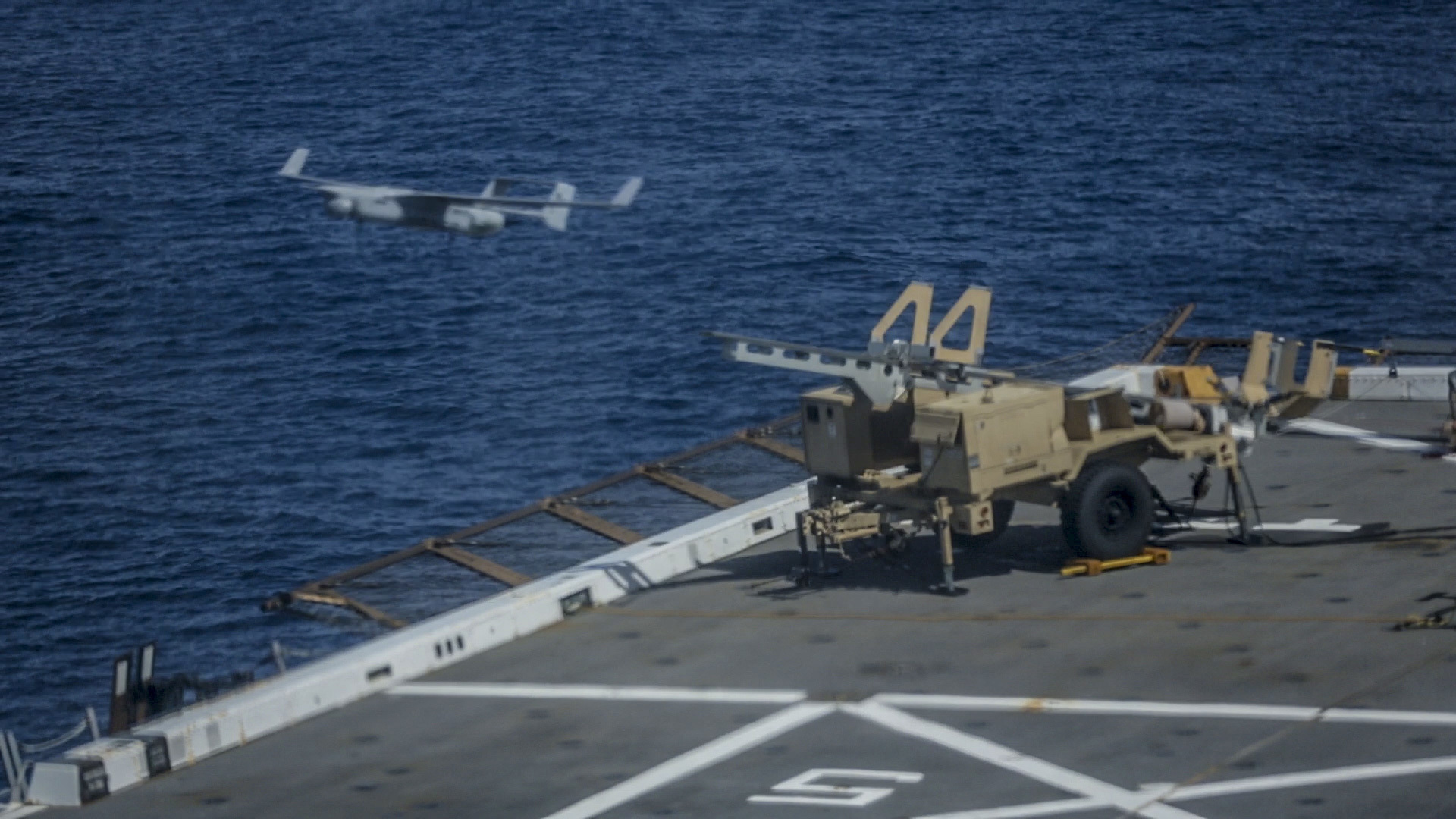

Russia wants to replace the helicopter scouts on its existing ships with longer-range drones. Announced earlier this week by Russia’s Advanced Research Foundation (an analog to the US’s DARPA), this new concept wants to have a drone launch a drone from a ship.
The process, in theory, starts with a cyclocopter, a drone that flies without rotors or traditional wings. Resting on the cyclocopter as a platform, a fixed-wing scout drone would be carried into the air. Then, with the cyclocopter flying forward, the fixed-wing drone would take off from it like it was on a runway, with the platform drone dropping away. For landings, the process would reverse, with the fixed-wing drone catching a ride on a moving platform, and then descending back to the ship.
This technological turducken uses a novel style of drone to overcome the limited space constraints on small ships. Not all ships have room for aircraft, and even when they do, only dedicated aircraft carriers have room for more than a couple of helipads. That’s the constraint that this concept is aiming to address—finite space that can at best accommodate vertical takeoff and landing by small aircraft.
As for the cyclocopters, those are strange also-rans in the history of early aviation. Essentially, instead of fixed wings jutting out the side, or a big rotor above the center mass of a vehicle, a cyclocopter features at least two partial cylinders, with blades in the cylinder, that spin to generate vertical lift and forward momentum. In appearance, it looks like a paddlewheel for air instead of water.
What makes it work as a way to fly is adjusting the angle of the blades in rotation and in flight, letting the same cylinders provide vertical lift, descent, or horizontal flight. As a concept, the design has roots back to the 1900s, though it has mostly remained more of an engineering curiosity than a workable machine.
[Related: DARPA’s Gremlin drones could be reloaded while airborne]
What makes it especially interesting for use on a ship is the way a cyclocopter can function as both landing pad and runway—but in the sky.
“The platform lifts an aircraft-type drone into the air, provides access to the desired speed and launch angle, as if it were taking off from an airfield. That is, it completely replaces the runway, becoming an airfield. Therefore, we called the platform ‘cyclodrome’ because it is like a compact ‘piece’ of an airfield,” Yan Chibisov, of the Advanced Research Foundation, told Russian state-owned media RIA Novosti. “On landing, the same platform catches up with the drone, flies up and picks it up itself. The task of the drone at this moment is simply to fly in a straight line. All operations should be carried out automatically without the participation of an operator.”
There’s a long history of aircraft launching from other aircraft, from airship-borne escort fighters in the 1930s to Virgin Galactic’s White Knight carrier launching its space-viewing pod from in flight. It is a process that drones make much easier as there’s no need to consider human comfort or limitations in the process.
[Related: This Airbus prototype could deploy drones from cargo planes]
At present, this scouting capability is carried out on Russia’s small warships by helicopters. Or, on ships too small to even fit a helipad, it is done by launching drones from rails and then those drones landing in nets. That’s a smaller footprint on the deck of a ship than a runway, though it’s also a lot more involved for the humans operating the drones, as the pilot has to immediately steer the drone after launch and the recovery team has to collect and detangle the drone upon its caught landing.
“The Russian Navy recognizes the current [Intelligence, Surveillance and Reconnaissance], anti-submarine and anti-mine challenge as limited by existing manned platforms – so it wants to make each vessel a carrier of aerial, surface and sub-surface drones and unmanned systems,” says Samuel Bendett, an analyst at the Center for Naval Analysis and adjunct senior fellow at the Center for New American Security. “This particular project advances the current Navy plans to station small aircraft and helicopter-type drones by proposing that a much larger long-range drone be available for naval ships even when there is no runway space.”
[Related: DARPA’s new combat drones could catch a ride from other aircraft]
Fielding more drones from more ships would let the Russian navy do a better job of finding and tracking threats at sea, from submarines to other surface fleets. Right now, some of that work is done by planes flying from shore, like the Ilyushin Il-38 “Dolphin,” in service since the 1960s.
“The impending arrival of large heavy drones like Altius will probably replace these crewed platforms,” says Bendett. “Today, the Russian Navy is using Forpost drones that are based on land for increased ISR capabilities – in Kaliningrad, Crimea and Kamchatka.”
Incorporating drones to replace existing crewed aircraft doesn’t mean getting rid of the human work requirements of those missions entirely. Instead, it shifts that human work to monitoring and reading the scans from the aircraft, letting humans interpret sensor data and scan for threats while autonomous flight systems keep aircraft aloft.
It is a promise of tech hopefully making the work easier. Even if, to get that tech to work, sailors will mount a drone on top of another drone, and then pilot both into the sky above the sea.
